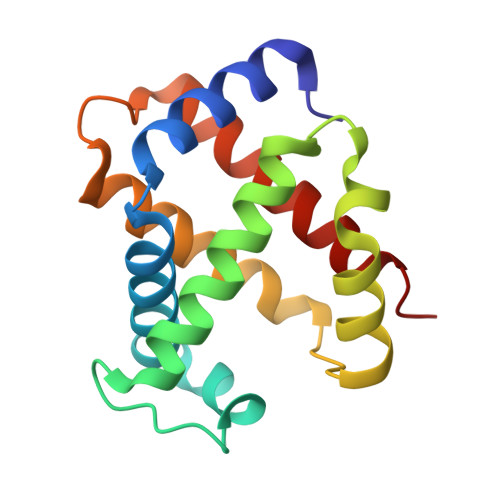X-ray crystallographic analyses of symmetrical allosteric effectors of hemoglobin: compounds designed to link primary and secondary binding sites.
Safo, M.K., Boyiri, T., Burnett, J.C., Danso-Danquah, R., Moure, C.M., Joshi, G.S., Abraham, D.J.(2002) Acta Crystallogr D Biol Crystallogr 58: 634-644
- PubMed: 11914488
- DOI: https://doi.org/10.1107/s0907444902002627
- Primary Citation of Related Structures:
1K0Y - PubMed Abstract:
The rational design and X-ray crystallographic analyses of two symmetrical allosteric effectors of hemoglobin (Hb) are reported. Compound design was directed by the previously solved co-crystal structure of one of the most potent allosteric effectors of Hb, 2-[4-[(3,5-dichlorophenylcarbamoyl)-methyl]-phenoxy]-2-methylpropionic acid (RSR4), which revealed two distinct binding sites for this compound in the Hb central water cavity. The primary binding site has been observed for all compounds of this structural class, which stabilize deoxy Hb by engaging in inter-dimer contacts with three of the four protein subunits. Interactions at the secondary binding site of RSR4 occur primarily between the beta(1) and beta(2) subunits and serve to further constrain the deoxy state. Based on these observations, it was hypothesized that compounds with the ability to simultaneously span and link both of these sites would possess increased potency, but at a lower molar concentration than RSR4. Two symmetrical compounds were designed and synthesized based on this hypothesis. The symmetrical effector approach was taken to minimize the number of compound orientations needed to successfully bind at either of the distinct allosteric sites. X-ray crystallographic analyses of these two effectors in complex with Hb revealed that they successfully spanned the RSR4 primary and secondary binding sites. However, the designed compounds interacted with the secondary binding site in such a way that intra-dimer, as opposed to inter-dimer, interactions were generated. In agreement with these observations, in vitro evaluation of the symmetrical effectors in Hb solution indicated that neither compound possessed the potency of RSR4. A detailed analysis of symmetrical effector-Hb contacts and comparisons with the binding contacts of RSR4 are discussed.
- Department of Medicinal Chemistry, School of Pharmacy and Institute for Structural Biology and Drug Discovery, Virginia Commonwealth University, Richmond, Virginia 23298-0540, USA. msafo@hsc.vcu.edu
Organizational Affiliation:




















